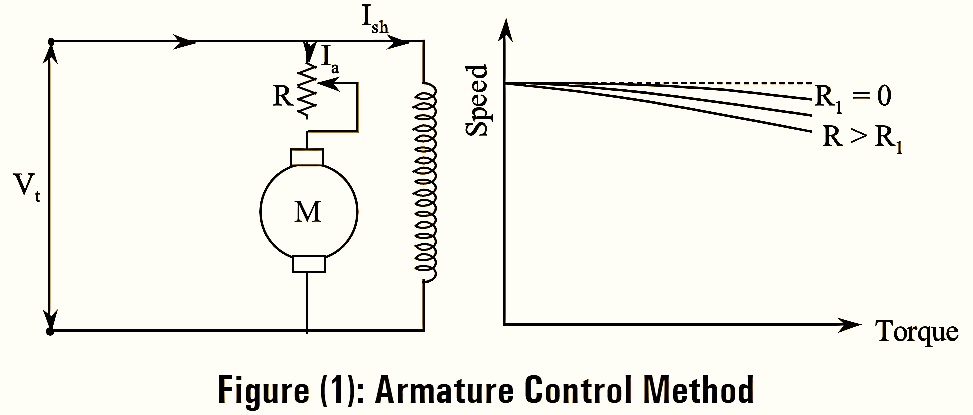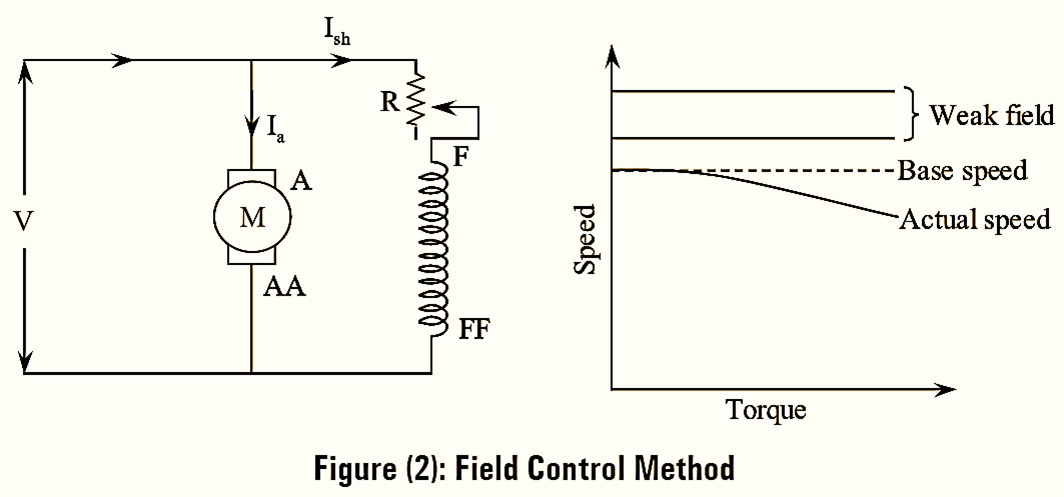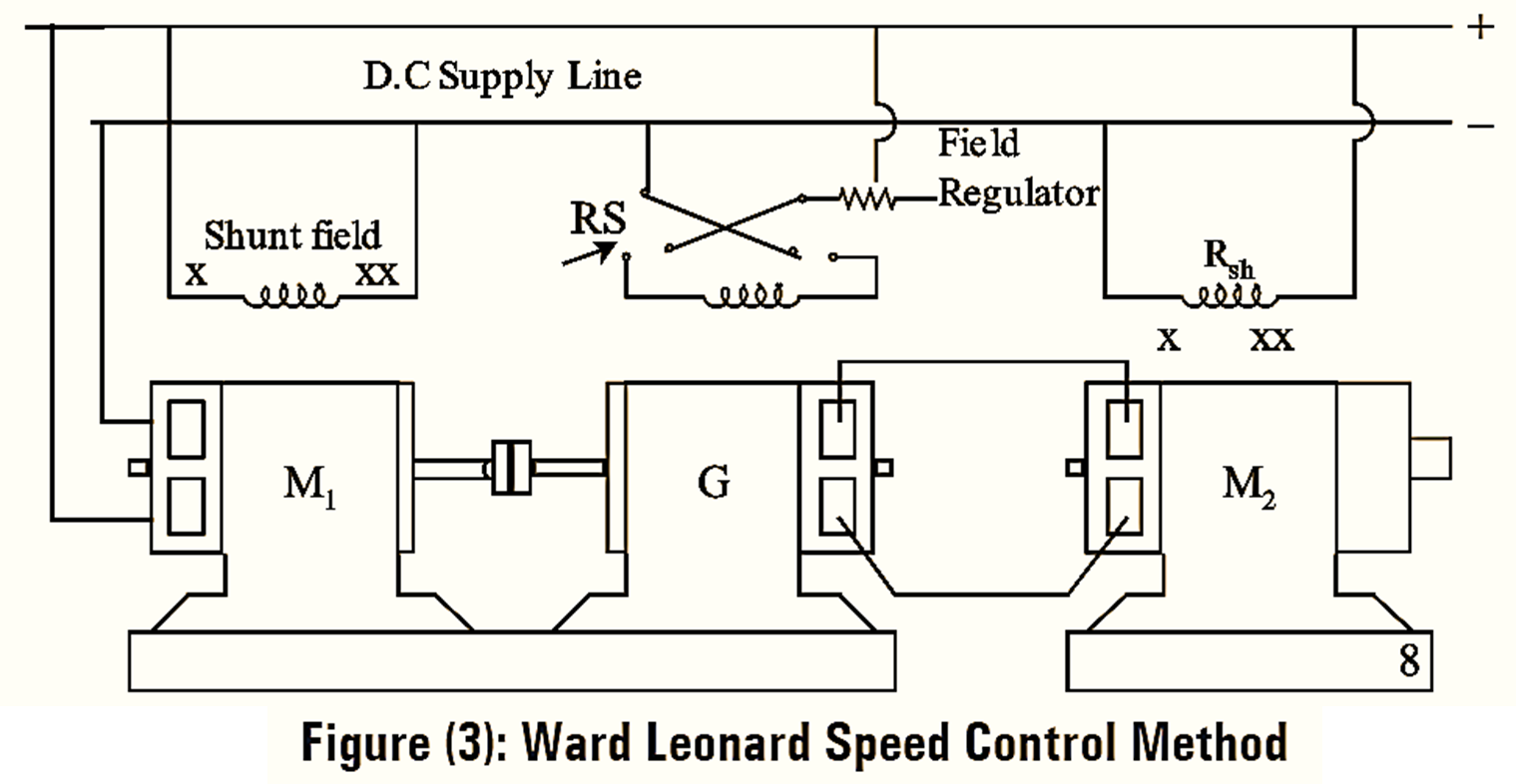The different methods of speed control of DC shunt motor are,
- Armature control method
- Field control method
- Ward-Leonard method.
Armature Control Method

In this method of speed control, an external variable resistance is connected between the armature terminals and the line.
When the resistance added is maximum due to higher resistance, the current flowing through the armature would be reduced proportionally. The field flux remains unchanged thus, with the reduction in the armature current, the torque is also reduced.
\[T={{k}_{a}}\oint{{{I}_{a}}}\]
As the torque of the machine is reduced, the speed also reduces. If the armature resistance is kept minimum, the rated current flows through the armature keeping the speed at rated value. Thus by analysis, it could be noted that the speed variation is possible only below the rated speed but not above the rated speed. The major advantage is that due to higher resistance in the armature the power losses considered would be large. So, it is used for intermittent periods only. The circuit and the characteristics are shown in figure (1).
Advantages of Armature control method
- This method of speed control is simple.
- Speed can be easily varied.
- Speeds below base speed or normal speed can be achieved easily.
- Initial cost required is low.
- Economical for short time speed control applications.
Disadvantages of Armature control method
- The operating cost increases for low speeds.
- There occurs power loss in controller resistance.
- Output and efficiency is reduced due to power loss.
- Speed regulation is poor.
Field Control Method

In field control method, a varying external resistance is connected in the field circuit. When the resistance added to the field is zero then the current through the armature would be the rated value. As the resistance increases the current through the field reduces thereby, reducing the flux of the machine. But this reduction of current in the field increases the current through the armature above the rated value and thus, the operating torque also increases which in turn increases the speed above the rated value. While starting, the field resistance should be kept minimum else huge current flows though the armature which damages the armature coils. So, from this it can be said that the variation of speed above the rated speed can also be obtained by increasing the field resistance.
Advantages of Field control method
The advantages of speed control of D.C motor using flux control method are as follows.
- Speed can be increased upto twice the rated speed.
- It is a very simple.
- Less amount of power is wasted as the field rheostat is connected across the field.
- Independent of load.
- It is the most efficient and economical method.
Disadvantages of Field control method
- Armature reaction is greater and results in instability at high speeds.
- Speeds below the normal speed cannot be controlled.
- Poor commutation.
Ward-Leonard Method

Ward Leonard system is used to control the speed of DC shunt motors. It comes under the category of voltage control method. In this method, the basic adjustable voltage to the armature is achieved by means of an adjustable voltage generator. The arrangement of Ward Leonard system is shown in figure (3).
As shown in figure, Ward-Leonard system consists of two motors M1 and M2. M1 is the motor whose speed is to be controlled. A motor-generator set consists of either DC or an A.C motor and is directly coupled to the generator G.
The input to the generator ‘G’ is fed from motor ‘M2‘ and the output of generator ‘G’ is applied to motor ‘M1 Motor ‘M2’ operates at constant speed. The voltage applied to motor ‘M1‘ is varied by connecting the field of generator to a regulator and hence variable voltage is applied to the armature of the main motor ‘M1‘ . Thus, speed control is achieved. The switch RS is used to reverse the direction of field current of generator ‘G’ i.e., when switch RS is in connected position, reverse voltage is generated in generator ‘G’ and is applied to motor ‘M1‘ due to which the direction of rotation of motor ‘M1‘ reverses.
Advantages of Ward Leonard method
- Speed can be controlled over the range from zero to normal speed in both the directions.
- Speed regulation is smooth.
- For large motors when a D.C supply is unavailable, this method is very much suitable.
Disadvantages of Ward Leonard method
- This method is expensive as it requires two extra machines.
- The overall efficiency of the system for light loads is low.
- There is a possibility for the armature winding to get damage when the applied voltage across the armature increases more than the rated voltage i.e., for a very long duration.
Comparison between different Methods of speed control of DC Shunt Motor
|
Field Flux Control Method |
Armature Resistance Control Method |
Armature Voltage Control Method |
| This method uses a control resistance inserted in the field circuit of the DC shunt motor. | This method uses a variable DC resistance connected in series with the armature of a DC shunt motor. | This method uses a variable voltage source separated from the source supplying the field current of DC shunt motor. |
| Speed is varied by varying the field flux. | Speed is varied by varying the armature circuit resistance and hence, the voltage across the | In this method, output delivered by the motor is decreased by decreasing the applied voltage and hence, decrease in speed of the motor is achieved. |
| In this method, the speed of DC shunt motor can only be varied above its base speed. | In this method, the speed control can be achieved only for speeds below base speed and the speed cannot be increased above the base speed. | In this method, speed control is possible only for below base speed values. |
| This method of speed control is very simple and most efficient. | This method gives lower effciency and poor speed regulation. | This method gives high effciency and good speed regulation. |
| This method is more economical. | This method requires high operational cost at reduced speed. | This method is more expensive in initial cost. |
| Speed can be increased to twice the rated speed using this method. | Speeds below base speed, down to creeping speeds of only a few r.p.m are easily obtainable. | Very fine speed control over the range from O to base speed in both directions can be achieved. |
| This method of speed control is extensively used in modern electric drives. | Due to considerable waste of energy at reduced speeds, this method is convenient and economical for short time or intermittent slow- down applications. | This method of speed control is largely used for modern high speed elevators and to some extent it is used for reversing planar installations. |